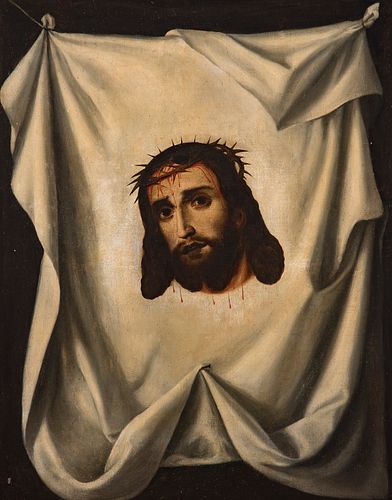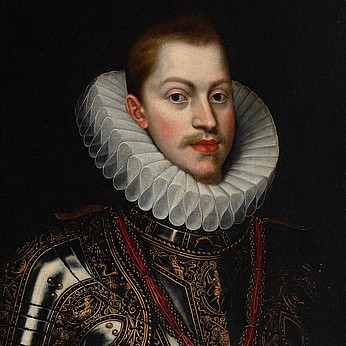School of FRANCISCO ZURBARÁN (Fuente de Cantos, Badajoz, 1598 - Madrid, 1664). "Santa Faz". Oil on canvas. Relined.
Lot 47
About Seller
Setdart Auction House
Carrer Aragó 346
Barcelona
Spain
Setdart Subastas was born in 2004 and is currently the first online art auction in Spain with solidity, prestige and reliability guaranteed by our more than 60,000 users. Setdart has a young, dynamic and enterprising team ready to successfully manage the purchase and sale of art works through custom...Read more
Estimate:
EUR€3,500 - EUR€4,000
$3,645.83 - $4,166.67
Absentee vs Live bid
Two ways to bid:
- Leave a max absentee bid and the platform will bid on your behalf up to your maximum bid during the live auction.
- Bid live during the auction and your bids will be submitted real-time to the auctioneer.
Bid Increments
| Price | Bid Increment |
|---|---|
| EUR€0 | EUR€10 |
| EUR€200 | EUR€25 |
| EUR€500 | EUR€50 |
| EUR€1,000 | EUR€100 |
| EUR€3,000 | EUR€200 |
| EUR€5,000 | EUR€500 |
| EUR€10,000 | EUR€1,000 |
| EUR€20,000 | EUR€2,000 |
| EUR€50,000 | EUR€5,000 |
About Auction
By Setdart Auction House
Nov 24, 2021
Set Reminder
2021-11-24 09:00:00
2021-11-24 09:00:00
America/New_York
Bidsquare
Bidsquare : Old Masters, Day 1
https://www.bidsquare.com/auctions/setdart-auction-house/old-masters-day-1-7873
Setdart Auction House sofia@setdart.com
Setdart Auction House sofia@setdart.com
- Lot Description
School of FRANCISCO ZURBARÁN (Fuente de Cantos, Badajoz, 1598 - Madrid, 1664). "Santa Faz". Oil on canvas. Relined. Presents repainting. Measurements: 73,5 x 59,5 cm; 94 x 78 cm (frame). In this devotional image painted in oil on canvas is represented the image of the face of Christ, which seems to be printed on the canvas of the Veronica. Jesus wears the crown of thorns, and shows the blood stains that show suffering or exhaustion. Looking directly at the viewer with a serious and emphatic gesture, but at the same time serene and calm, the image thus reflects Christ as savior and redeemer. The iconography of the Holy Face has its origin in the episode that occurred during the Passion of Christ, when on the way to Calvary a woman took off her veil to wipe the face of the Messiah with it. The image of the face of Jesus Christ was imprinted on the linen handkerchief, and it was miraculously preserved through the centuries, becoming an object of worship. The woman would later be called Veronica, whose etymology derives from the Latin "verum" (true) and the Greek "eikon" (image). The Holy Face is one of the most famous relics of Christianity, first described in 1137. The theme of the Santa Faz was taken up by Francisco Zurbarán at a time when works with this theme were no longer common. Francisco de Zurbarán trained in Seville, where he was a disciple of Pedro Díaz de Villanueva between 1614 and 1617. During this period he would have the opportunity to meet Pachecho and Herrera, and to establish contacts with his contemporaries Velázquez and Cano, apprentices like him in Seville at the time. After several years of diverse apprenticeship, Zurbarán returned to Badajoz without undergoing the Sevillian guild examination. He settled in Llerena between 1617 and 1628, a city where he received commissions both from the municipality and from various convents and churches in Extremadura. In 1629, by unusual proposal of the Municipal Council, Zurbarán settled definitively in Seville, beginning the most prestigious decade of his career. He received commissions from all the religious orders present in Andalusia and Extremadura, and was finally invited to the court in 1934, perhaps at the suggestion of Velázquez, to participate in the decoration of the great hall of the Buen Retiro. Back in Seville, Zurbarán continued to work for the court and for various monastic orders. In 1958, probably moved by the difficulties of the Sevillian market, he moved to Madrid. During this last period of his production, he painted canvases of private devotion of small format and refined execution. Zurbarán was a painter of simple realism, excluding grandiloquence and theatricality from his work, and we can even find some clumsiness when solving the technical problems of geometric perspective, despite the perfection of his drawing in anatomies, faces and objects. His severe compositions, rigorously ordered, reach an exceptional level of pious emotion. With respect to tenebrism, the painter practiced it especially in his first Sevillian period.
- Shipping Info
-
In-house shipping available. Please inquire at admin@setdart.com.
-
- Buyer's Premium



 EUR
EUR CAD
CAD AUD
AUD GBP
GBP MXN
MXN HKD
HKD CNY
CNY MYR
MYR SEK
SEK SGD
SGD CHF
CHF THB
THB
















